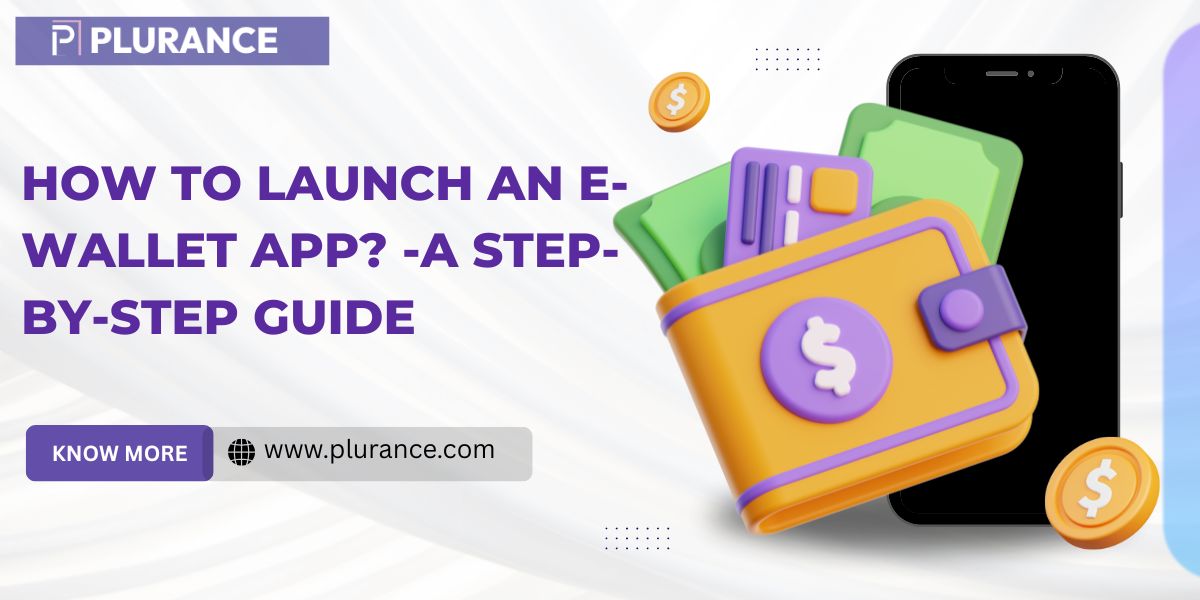In today's fast-digitalising world, the usage of E-Wallets for payments have taken centre stage in the field of payment modes. E-wallets are electronic wallets with a possibility that has revolutionised the way we make an entire financial transaction and made payments from buying products for everyday use to managing finances seamlessly. There are bountiful benefits of using e-wallets that simplify our lives but boost security and efficiency as well.
In this blog, we'll delve into the significant advantages of using e-wallets, shedding light on how E-Wallet apps launched.
What is an E-Wallet App meant for ?
An E-Wallet refers to a secured, software-based system for storing and managing payment information in a digital format. Users can save all their credit card details, debit card info, bank account information, and even loyalty points in one place with the help of an E-Wallet. Most E-Wallets use encryption and tokenization for the protection of user data. With the transformation of your payment details into a unique code for each transaction, this guarantees personal information cannot be compromised, making E-Wallets a safe choice for everyday transactions.
Overview of E-Wallet App statistics
- According to research from Statista, the worldwide digital payments market that was valued at nearly $4 trillion in 2020 will be more than $10 trillion in 2026. By 2030, the U.S. market will be well over $607.9 billion.
- According to Juniper Research, only 4 billion digital wallets were used in 2022, which will increase to 5.2 billion in 2026. This translates to a growth rate of 53%.
- According to statistics, over 65% of consumers in the United States have utilized electronic wallets at least once in the month, so that's a good reflection of how they love using it.
- The industry of retail and eCommerce is currently the highest-earning for the E-Wallet market, as it has a global marketplace of 30%, which is also the greatest market share, according to Grandviewresearch.
- Stats from 2022 show that 32% of global PoS transactions were done via a digital wallet, making it the most prevalent means.
- Most popular E-Wallet apps in the US include PayPal, Apple Pay, and Google Pay.
Why create an E-Wallet app ?: Benefits for your business
Insights That Matter
E-Wallet application development actually means a lot of data to help businesses understand their customers' spending habits and patterns. If such information is available, the business can customize its offers and earn higher returns on the implementation.
Expense Tracking
Most E-Wallet applications offer transaction history and categorization to help you monitor your budget properly. One such advantage of expense tracking by E-wallets is valuable to individuals like students who have limited means and need to make every penny count.
Decreases Fraud
Fraudulent activities tend to reduce with E-Wallet transactions as they have a robust security structure, including multi-factor authentication for the safety of transactions. In addition, every transaction is uniquely time stamped with date-time stamps and sender and receiver details. In case a customer pays mistakenly, this evidence helps to reclaim or claim fraud.
Transaction and Refund
All transactions are conducted fast and securely using near field communication (NFC) or QR code scans in e-wallets. Refunds are also possible as the users will find the money deposited directly back to the account or E-Wallet quickly.
Global Accessibility
E-wallets are widely accepted, posing great advantages for travelers and for anyone who participates in international transactions. The greatest strength of e-wallets is global accessibility, which makes e-wallets practically indispensable not only to the frequent traveller but also to a person involved in international transactions.
Environmental Impact
Tracking E-Wallet transactions eliminates paper receipts and bills, thereby providing an eco-friendly alternative to financial transactions. E-wallets may be said to promote sustainability and environmentally friendly financing above anything else.
Bagging a Successful Launch for Your E-Wallet App: A Step-by-Step Guide
Creating an E-Wallet application is quite an inventive and technical task. So, before you step into the development process, it would be great if you could understand it very well. Now, let's discuss in detail each step. Below, we would be focusing on how to develop an E-Wallet application.
Stage 1: Planning
In the first step, you will need to determine who your target audience is and to choose a platform in use by these people. Afterward, create a strategy describing how the customer will be taken through the various levels of the E-Wallet app. Basically, give them clear instructions on where to click and what will happen as they click certain screens.
Stage 2: Competitor Analysis
Conduct an extensive search on the market to see what E-Wallet apps already exist. Check for the popular features these apps have and find out the gaps. Competitive analysis will help you find ways of actually making your E-Wallet app different and unique from others in such an established market.
Step 3: Develop Feature List
The next action is to create a proper feature list for your E-Wallet app according to your research findings. Important features are described in detail, including transaction tracking and account management. Furthermore, an attractive consideration could be the incorporation of a unique offering, such as an investment option or loyalty programs. These features should be prioritized based on customer requirements and feasibility of development, thus producing a development roadmap for the E-Wallet app.
Stage 4- App UI/UX Design
At the UI, UX design phase, the application obtains a visible look. This simply means that the interface at which the users will engage needs to be smooth, easy-to-use, and gains the user's attention. It should be appealing and quite easily navigated: the tiles are user-friendly, fast, and straight in processing pathways between complex financial processes to yield user-friendly travel. Choose navigation elements, fonts, colors, and layout, among others in designing it.
Step 5: Right Technology Selection for E-Wallet App
Choosing the correct technology stack with a keen eye becomes essential towards the paid app's E-Wallet scalability and performance. It could be a thing about the app platform, frameworks to use, and those programming languages. The technology also gives a good view on security issues as it covers most features the application should encapsulate.
Step 6: APIs And Backend Development
APIs link your application to other services such as payment networks and banks, allowing different financial transactions to occur within your E-Wallet app. The backend is where processing of all data is done; thus, it should be very secure and efficient. Design it for handling data and users' accounts and transactions safely.
Step 7: Enhance Security
Security is of utmost importance in finance applications. Adopt strong safety measures, like multi-factor authentication and encryption, to protect sensitive information of users. Carry out regular audits of security and comply with regulatory standards to maintain trust.
Step 8: Integrate Payment Gateway
Payments are extremely vital for every E-Wallet app. Credible payment gateways should be incorporated to allow users to connect their credit cards, banks, and other payment methods securely. Simple payment will be the key consideration of the procedure, which may also need to handle multiple currencies when and if required.
Step 9: Testing E-Wallet App
Before launching, the testing of the E-Wallet app should be exhaustive enough to discover and resolve all bugs. It serves an important task in your E-Wallet app development process in ensuring that everything functions correctly. This scope involves testing for security, usability testing, and performance testing. Quality assurance is a continual process meant to deliver a good user experience.
Step 10: Launch, Maintenance, And Enhancements
Launch phase will entail a proper deployment of the E-Wallet app for users to access it live. The E-Wallet App will have a dashboard for monitoring its success and performance. You should monitor its performance and user reviews in a timely manner to fix the issues. Your digital wallet app should grow together with its users by embracing new technology and keep upgrading in order to remain in the market.
How To Set Up A Secure Digital Wallet ?
While retailers are given a tokenized representation of your card account details, they do not get access at any time to your real number, thus reducing the risk of fraudsters using or seeing your financial information.
Two-Factor Authentication (2FA): Increasing security for an app is possible by requiring users to confirm transactions through another authentication factor, like SMS codes or any form of identity verification.
Passcode and Biometric Authentication: Incorporate a unique password for application logins and keep watching the accounts for any suspicious activity; it is the most robust deterrent against intruders.
Securitize Data Transmission: Implement SSL/TLS/VPN encryptions so that secure and fast transaction experiences work between the application and server.
Point-to-Point Encryption: Initiating a transaction by swiping a mobile phone across a Point-of-Sale (PoS) terminal starts the whole encryption process, and it continues until the completion of the transaction.
To be Conclude
To sum up, we are in the digital age when everything is moving towards E-Wallet mobile apps, which serve as alternative secure tools to manage finances with a lot of conveniences. By learning about the stages of mobile wallet development in its general form, any business can take mobile payments and engagement with customers to a whole new level. Partnerships with a reputable E-Wallet App Development Company like Plurance is essential to the development of a successful e-wallet app with satisfied users and compliance with laws. E-wallets, partnered with the right expertise and strategy, can actually be beneficial towards the growth of the businesses as well as innovation in the digital space.




















 IND
IND














